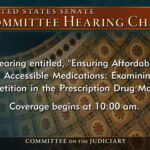The Economics of “Delinking” PBM Compensation
Alex Brill
Pharmacy benefit managers (PBMs) are a popular Congressional target of late. The desire to control or restrict PBMs stems from a misconception about the role they play in the pharmaceutical supply chain. In reality, PBMs negotiate lower prices from drug manufacturers, and the savings are generally passed along to health plan sponsors and used to lower health insurance premiums. Hampering PBMs’ ability to do their job has been shown to increase healthcare costs.
Among the array of PBM policies under Congressional consideration is one known as “delinking,” which would ban PBM compensation in Medicare Part D from being tied to a drug manufacturer’s list price. In other words, proposed legislation would restrict the private contracting terms between PBMs and the health plans providing prescription drug coverage to seniors and force PBMs to delink their business arrangements from the value of their services.
Cost of Delinking in Medicare Part D
University of Chicago Professor Casey Mulligan recently investigated the likely economic cost associated with this proposal in a working paper published by the National Bureau of Economic Research. He finds that removing an incentive for PBMs to negotiate with manufacturers for the lowest net price (the price after discounts and rebates) will likely result in higher costs for patients and taxpayers and more revenues for drug manufacturers and others. As Mulligan explains:
Incentives matter for PBMs just as they do for other market participants. A financial reward for greater rebates and discounts results in greater rebates and discounts. Conversely, eliminating pay for PBM performance would reduce PBM performance. Absent the financial incentives, plans would pay more to manufacturers and to pharmacies because plans would receive less manufacturer rebates and pharmacy discounts.
Mulligan’s model, specific to the characteristics of the Medicare Part D program and patient population, estimates that reduced incentives for PBMs to negotiate lower prices would result in an increase in drug prices of 5–18 percent. This in turn would induce some reduction in demand for prescription drugs. Taken together, these dynamics would result in Medicare premium costs rising between $4 billion and $13 billion. Of that increase, the federal government’s share would be $3 billion–$10 billion.
Mulligan’s research also empirically estimates the potential impact of delinking on other members of the pharmaceutical supply chain, including drug manufacturers, who would see an increase in profits of $3.1 billion–$10.6 billion. Finally, Mulligan estimates the impact of delinking on other aspects of the healthcare system, including an increase in nondrug healthcare costs of $0.2 billion–$0.6 billion and the cost of forgone drug innovation ($0.5 billion–$1.7 billion).
Cost of Delinking in Commercial Health Insurance
The risk of government intervention into the operations of PBMs is not limited to Part D. Some lawmakers have proposed delinking PBM compensation from price across all PBM lines of business, including commercial insurance.
How would delinking impact the commercial market? The findings from Mulligan’s research on the impact of delinking on Part D can serve as a useful basis for answering this question. While the commercial health insurance market covers many more individuals than Medicare Part D (about 176 million vs. 49 million), the Medicare population tends to use more prescription medicines. National Health Expenditure Accounts (NHEA) data for 2021 show that per-capita retail pharmacy prescription drug sales were $1,147, while per-capita drug spending in Part D was more than twice that amount.
NHEA also reports that aggregate retail prescription drug spending was $119.9 billion for Medicare and $151.7 billion for private health insurance, a difference of more than 25 percent. Considering just the difference in aggregate spending, this suggests that the increase in premiums in the commercial market would be $1 billion–$3 billion greater than in Part D, or $5 billion–$16 billion in total.
This likely underestimates the economic harm of delinking in the commercial market. Recall that rebates reflect the savings generated for health plans as a result of the incentives in place today for PBMs. Curtailing such incentives will result in fewer rebates and thus higher net costs. Mulligan assumes $31 billion in annual rebates in Part D, but recent evidence from Nephron Research estimates that rebates for commercial drug coverage reached $64 billion in 2022. With this assumption in place of Mulligan’s, the impact of delinking in the commercial market rises to an increase in premiums of $8.4 billion–$26.6 billion. Additionally, this estimate only comprises premium increases. It does not include the increased nondrug health costs and the cost of reduced innovation that Mulligan also estimates.
A significant share of these higher costs (an estimated $6.3 billion–$21.9 billion) would accrue to drug manufacturers. Recall that Mulligan estimated that drug manufacturer profits in Part D would increase by $3.1 billion–$10.6 billion. Therefore, the aggregate effect of delinking in the commercial market and Part D could be an increase of more than $32 billion in drug profits.
Mulligan’s research finds that imposing constraints on the contracts between PBMs and health plans offering Part D drug coverage would not yield better outcomes for seniors or taxpayers. As this simple extrapolation to commercial insurance shows, delinking PBM compensation in the commercial market would be even costlier to health plan sponsors and patients. Before members of Congress pursue this policy in either market, they should understand its true impact: higher costs, not healthcare savings.












